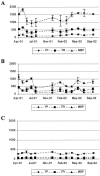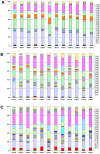Distribution and stability of sulfate-reducing prokaryotic and hydrogenotrophic methanogenic assemblages in nutrient-impacted regions of the Florida Everglades
- PMID: 15870361
- PMCID: PMC1087591
- DOI: 10.1128/AEM.71.5.2695-2704.2005
Distribution and stability of sulfate-reducing prokaryotic and hydrogenotrophic methanogenic assemblages in nutrient-impacted regions of the Florida Everglades
Abstract
Although the influence of phosphorus loading on the Everglades ecosystem has received a great deal of attention, most research has targeted macro indicators, such as those based on vegetation or fauna, or chemical and physical parameters involved in biogeochemical cycles. Fewer studies have addressed the role of microorganisms, and these have mainly targeted gross informative parameters such as microbial biomass, enzymatic activities, and microbial enumerations. The objectives of this study were to characterize the dynamics of sulfate-reducing and methanogenic assemblages using terminal restriction fragment length polymorphism (T-RFLP) targeting the dissimilatory sulfite reductase (dsrA) and methyl coenzyme M reductase (mcrA) genes, respectively, and assess the impact of nutrient enrichment on microbial assemblages in the northern Everglades. T-RFLP combined with principal component analysis was a powerful technique to discriminate between soils from sites with eutrophic, transitional, and oligotrophic nutrient concentrations. dsrA T-RFLP provided a higher level of discrimination between the three sites. mcrA was a relatively weaker system to distinguish between sites, since it could not categorically discriminate between eutrophic and transition soil samples, but may be useful as an early indicator of phosphorus loading which is altering hydrogenotrophic methanogenic community in the transition zones, making them more similar to eutrophic zones. Clearly, targeting a combination of different microbial communities provides greater insight into the functioning of this ecosystem and provides useful information for understanding the relationship between eutrophication effects and microbial assemblages.
Figures






References
-
- Atlas, R. M., A. Horowitz, M. Krichevsky, and A. K. Bej. 1991. Response of microbial populations to environmental disturbances. Microbial. Ecol. 22:249-256. - PubMed
-
- Bak, F., and N. Pfennig. 1991. Microbial sulfate reduction in littoral sediment of Lake Constance. FEMS Microbiol. Ecol. 85:31-42.
-
- Barnett, C., and M. Vogel. 2001. Fragile. Florida Trend 2001(March):50-60. http://www.floridatrend.com/issue/default.asp?a=4303&s=1&d=3/1/2001.
-
- Bates, A. L., W. H. Orem, J. W. Harvey, and E. C. Spiker. 2002. Tracing sources of sulfur in the Florida Everglades. J. Environ. Qual. 31:287-299. - PubMed
-
- Bates, A. L., E. C. Spiker, and C. W. Holmes. 1998. Speciation and isotopic composition of sedimentary sulfur in the Everglades, Florida, USA. Chem. Geol. 146:155-170.
Publication types
MeSH terms
Substances
LinkOut - more resources
Full Text Sources

